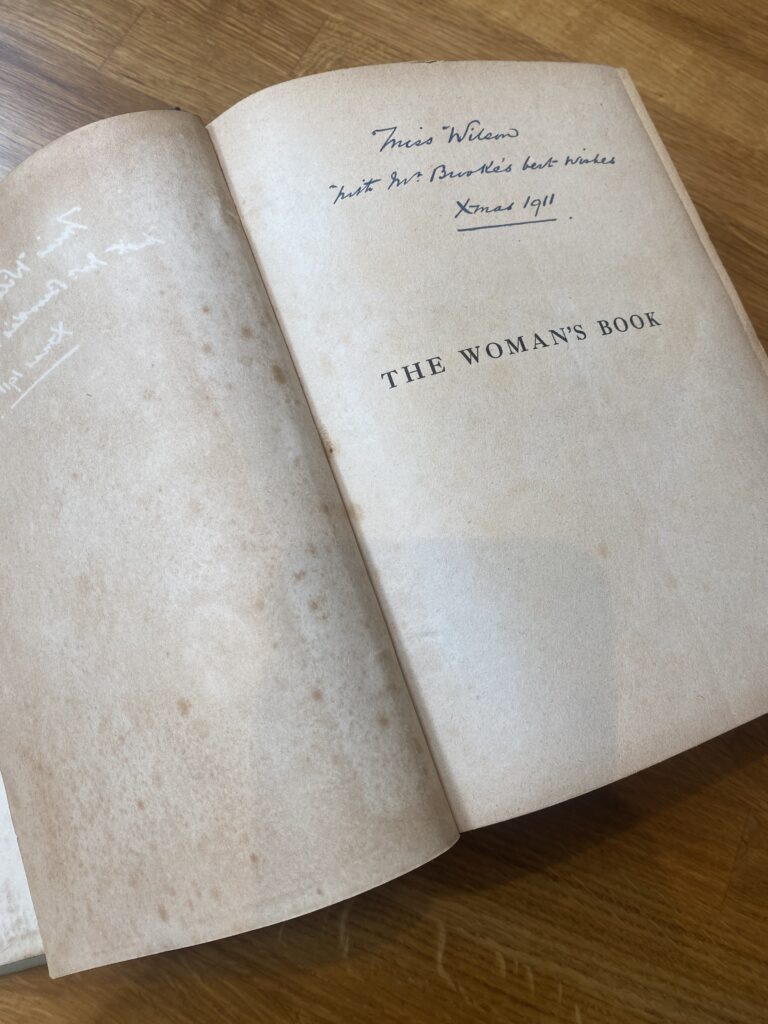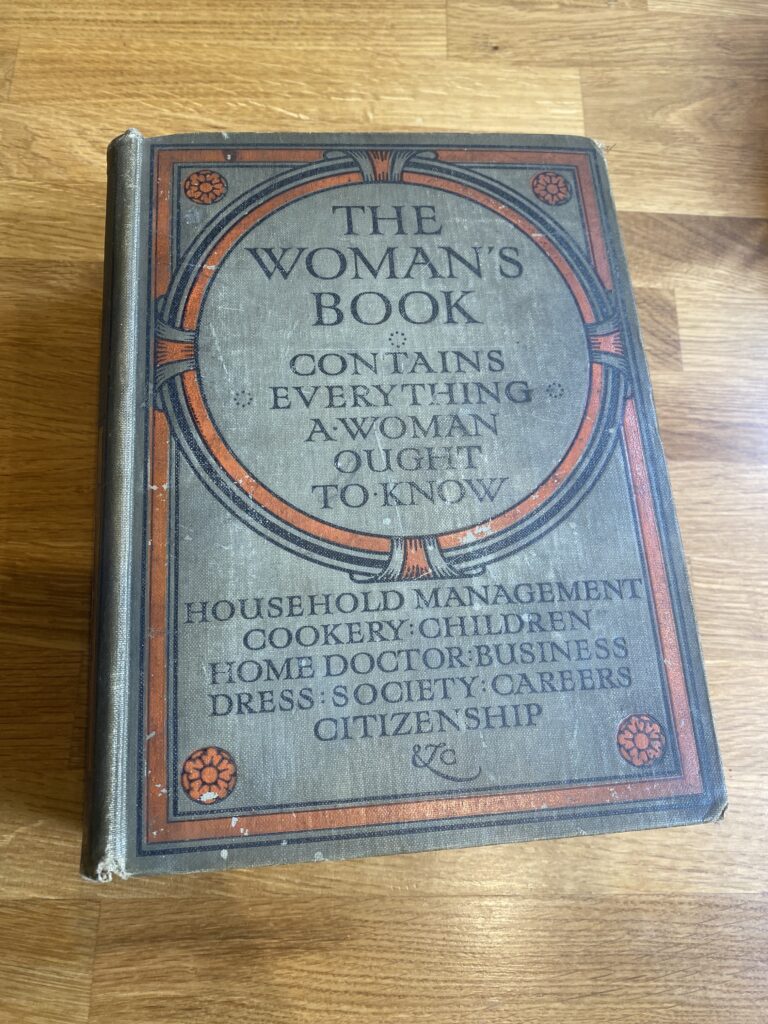Alex Citrin / The Met's Open Access Initiative
“Everything a Woman Ought to Know”
According to one book, both a lot and very little has changed in the last 100 years.
From the moment I saw The Woman’s Book sitting on a dusty shelf in a secondhand shop, I knew I had to rescue it. I was fascinated: At 719 pages, the hefty tome—browned around the edges and threatening to fall apart—promised to teach well-off British women of 1911 everything they ought to know about womanhood, from poultry-keeping to child-rearing to overseeing the servants.
According to the hand-inked inscription, one lucky Miss Wilson received the manual as a Christmas gift in 1911, with “best wishes” from what looks to be a “Mr. Brooke.” Color me intrigued as to that relationship—but flipping through it, I could only assume that this Mr. Brooke had hoped to begin training his intended future wife, by sending her a literal manual on womanhood. While laying out various tasks, the book gives hints at what a woman’s purpose was in the early 20th century. The gentlewoman’s aim is to avoid attracting the eye of the crowd. To contain boisterous laughter. To please.
So much has changed! I thought. But so little had, too.
There’s plenty in The Woman’s Book that feels like it’s from another world — the etiquette of visiting cards, how to make a fur muff. Yet a lot also feels familiar: the domestic and family labor that too naturally falls to women, the fact that if we want to embark on certain careers, we better expect a fight to get there. While some of the details might differ, it’s clear that the ultimate purpose of this prescriptive book was to tell women how to exist—and in that regard, we have work to do.
 Courtesy of the author.
Courtesy of the author.On Pregnancy
When I picked up The Woman’s Book, I was heavily pregnant, and reading every feminist birthing book I could get my hands on (a sure fire way to terrify yourself about childbirth). I immediately skipped to the baby section to find out what the women of the early 20th century were being told, only to discover that the section titled “Baby’s Arrival” was merely two paragraphs long, with nothing whatsoever about the act of giving birth itself.
On the general topic of dressing during pregnancy, however, there was a full page: three times the space given to pushing the thing out. One important part of pregnancy that is very well covered is whether or not one should wear a corset when with child—not for the safety of the fetus, of course, but because “an effort must be made to avoid appearing conspicuous.” (The author’s advice is to keep the corset, but to wear ones that aren’t quite so tight, giving an inch of priority to health over some idea of vanity.)
And ladies, no snacks during this special time (or, actually, ever), no trips to the theatre, and for god’s sake, please do avoid traveling by bus, train, or tram towards the end of the final trimester. Most importantly, “All morbid and sensational literature should be avoided.”
Over a century later, people who are not medical professionals still tell pregnant women what to do and when. We’re told to take all the drugs, do it without drugs, have a birth plan, don’t have a birth plan— meanwhile, some pregnant women aren’t told an awful lot at all. But never is unwanted advice more abundant than during this magical time. When a yoga teacher told me I had complications in birth because I “didn’t try hard enough” to do it naturally, it took every ounce of peace I had left not to finish her off with a flying warrior pose. I imagine I’d have felt the same if someone chided me for not wearing the proper pregnancy corset.
On Beauty
Unsurprisingly for a book with such strong opinions on pregnancy fashion, The Woman’s Book also has a fair amount of beauty advice. The book is packed with gold like: “Try and cultivate a more cheerful outlook upon life if you would permanently rid yourself of these vexing little lines between brows” and “Overwork and worry are powerful deterrents to all culture of beauty.” Because we women really should prioritize the absence of wrinkles over thinking too hard, of course. (For the record, mischievous grey hairs are usually also caused by worry—so we should all really just STOP WORRYING if we want to remain youthful.)
It’s also in this chapter that it becomes clear who, exactly, the book is targeting. One tip in particular that speaks pretty strongly to the diversity of the UK’s upper-class in 1911 is a set of instructions on how to whiten your neck and arms. For real. It involves bathing in milk (the service of dairy cows is never ending) and dusting on plenty of powder, effectively telling wealthy white women to transform themselves into donuts in order to be beautiful.
But don’t fret gentlewomen, because by 2024, we’ve been freed from this obsession with how contorting our faces makes us hideous, how our bodies must be a certain way, and why any of that matters. Unless of course you count the endless “new beauty obsessions” we’re encouraged to spend our hard-earned money on (which we still make less of than men, of course), the smoothing Instagram filters that it’s now normal to view the world through, and the constant need to define a bikini body as anything other than a body that happens to have a bikini on it.
On Work
After I got the book home safely, I decided to take a closer look at the contents page. Did I spy “careers for women” and “women in politics”? Had I been too quick to judge?
What’s incredible is that Florence B. Jack, the editor of The Woman’s Book, suggests the 1911 woman has it pretty good in the world of work. There are many vocations for a young lady, unlike in those pesky olden times. A woman can be a teacher, a private secretary, a florist, a beekeeper, even a lady clerk, for heaven’s sake! (Not to be confused with a regular clerk, of course.) She can also be the most “womanly profession” of them all: a nurse. But no matter your choice, Jack cautions, there is a catch—you have to be really good. There’s no room for mediocrity when you’re a woman. (Arguably, still true today.)
When it comes to my own profession of journalism, I might have found breaking through a bit trickier in 1911, as Jack warns this is a job “not so easily accessible as other callings.” It’s possible, but the budding female journalist has to be “really clever.” When it comes to training, a girl should get a position as a typist or secretary in a newspaper office. Leave journalism school to the chaps, eh? But if a woman is able to make a success of being a reporter, “her powers of intuition and her tact are so much greater than that found in the average man reporter that she is at times entrusted with very special duties.” Imagine that. An exceptional employee being given more responsibility than an average one. Do we even need feminism anymore?
Shockingly, the book also gives women of 1911 permission to be a doctor. It only asks that there be no female medical students at Oxford and Cambridge, thank you very much. Apparently there’s little “old-fashioned prejudice against the ‘woman doctor’” anymore, either, and even more encouragingly, “there is none of that ‘under-cutting of fees’ which has to be adopted by women in most other professions.” So if you want to earn the same as a man for the same job (will we women ever be satisfied?), start getting to grips with human biology. (Perhaps just don’t consult The Woman’s Book for anatomy lessons.) Oh, and if being a woman surgeon (prefix compulsory, of course) is your raison d’etre, best to get a new raison, because in this profession above all others, “prejudice will prove one of the most formidable opponents.” That old chestnut.
Comparatively, you would hope advice on “careers for women” in 2024 would encourage you to do any job you damn well please. But of course, that doesn’t mean that women and nonbinary people are treated the same as their male coworkers. Call me when female pilots aren’t getting mistaken for air stewards and the gender pay gap has been eradicated. And that’s before we intersect gender with class, race, geography, sexuality, and everything else that has an impact on salary and treatment in the workplace.
On Politics
At last, we get to “women in politics.” In 1911, British women could be canvassers, speakers, and campaign organizers. But let’s not get carried away—they couldn’t be trusted to actually vote, let alone stand as political candidates themselves. Still, after all the advice on household management, what to wear, and how to correctly visit your neighbors, I was surprised that the final section of The Woman’s Book turned to the women’s suffrage movement. Now the men have lost interest, it seems to suggest, here’s what we really think.
There’s plenty of talk of servants and country houses throughout The Woman’s Book, so it’s no surprise that it wasn’t a book for all women: It was a book for privileged women. But I found it somewhat encouraging that one of its final comments is devoted to how the suffragist movement brought together women of all classes and politics, “the peeress and the laundry girl,” walking together in processions and fighting for what’s right. In particular, Jack talks about women’s desires to improve work and wages, so that work could be judged by its “true market value and not by the sex of the worker.” It’s a passionate take on why women want freer lives, and how their involvement in politics can create better circumstances for all of humanity.
In many ways, the same holds true today—and frustratingly, it feels like we’re still fighting for the same things. It also feels like we’re still fighting against the same things, too. I don’t know that a Woman’s Book of 2024 would pay quite so much attention to how to iron frills. But look at the pages of mainstream publications targeted at women and there’s an abundance of pieces on how to outfit prep, how to make a charcuterie board bigger than your actual house, and how to get a smoky lip. Aren’t we still being told how to exist? Isn’t this more of the same?
If instead of treating it as an endnote, there was a central focus on how to collectively push for progress for all of us, we might just be able to surpass all these objective measurements of how a woman should “be,” and instead tick the box of what we actually ought to know.
 Courtesy of the author.
Courtesy of the author.Posted in history


